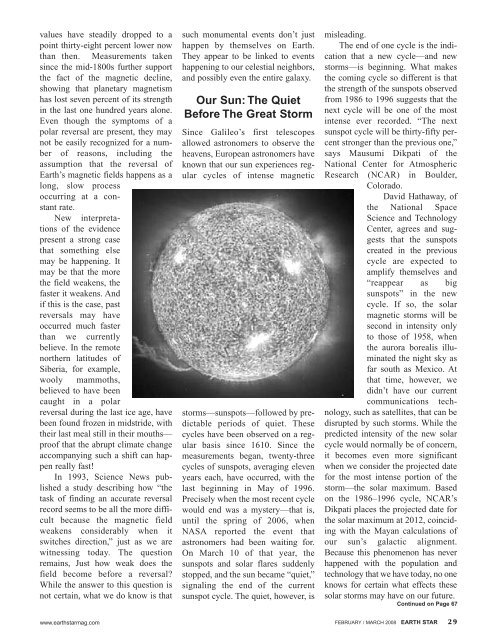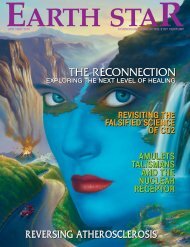GREGG BRADEN GREGG BRADEN - Earthstar
GREGG BRADEN GREGG BRADEN - Earthstar
GREGG BRADEN GREGG BRADEN - Earthstar
- No tags were found...
Create successful ePaper yourself
Turn your PDF publications into a flip-book with our unique Google optimized e-Paper software.
values have steadily dropped to apoint thirty-eight percent lower nowthan then. Measurements takensince the mid-1800s further supportthe fact of the magnetic decline,showing that planetary magnetismhas lost seven percent of its strengthin the last one hundred years alone.Even though the symptoms of apolar reversal are present, they maynot be easily recognized for a numberof reasons, including theassumption that the reversal ofEarth’s magnetic fields happens as along, slow processoccurring at a constantrate.New interpretationsof the evidencepresent a strong casethat something elsemay be happening. Itmay be that the morethe field weakens, thefaster it weakens. Andif this is the case, pastreversals may haveoccurred much fasterthan we currentlybelieve. In the remotenorthern latitudes ofSiberia, for example,wooly mammoths,believed to have beencaught in a polarreversal during the last ice age, havebeen found frozen in midstride, withtheir last meal still in their mouths—proof that the abrupt climate changeaccompanying such a shift can happenreally fast!In 1993, Science News publisheda study describing how “thetask of finding an accurate reversalrecord seems to be all the more difficultbecause the magnetic fieldweakens considerably when itswitches direction,” just as we arewitnessing today. The questionremains, Just how weak does thefield become before a reversal?While the answer to this question isnot certain, what we do know is thatsuch monumental events don’t justhappen by themselves on Earth.They appear to be linked to eventshappening to our celestial neighbors,and possibly even the entire galaxy.Our Sun: The QuietBefore The Great StormSince Galileo’s first telescopesallowed astronomers to observe theheavens, European astronomers haveknown that our sun experiences regularcycles of intense magneticstorms—sunspots—followed by predictableperiods of quiet. Thesecycles have been observed on a regularbasis since 1610. Since themeasurements began, twenty-threecycles of sunspots, averaging elevenyears each, have occurred, with thelast beginning in May of 1996.Precisely when the most recent cyclewould end was a mystery—that is,until the spring of 2006, whenNASA reported the event thatastronomers had been waiting for.On March 10 of that year, thesunspots and solar flares suddenlystopped, and the sun became “quiet,”signaling the end of the currentsunspot cycle. The quiet, however, ismisleading.The end of one cycle is the indicationthat a new cycle—and newstorms—is beginning. What makesthe coming cycle so different is thatthe strength of the sunspots observedfrom 1986 to 1996 suggests that thenext cycle will be one of the mostintense ever recorded. “The nextsunspot cycle will be thirty-fifty percentstronger than the previous one,”says Mausumi Dikpati of theNational Center for AtmosphericResearch (NCAR) in Boulder,Colorado.David Hathaway, ofthe National SpaceScience and TechnologyCenter, agrees and suggeststhat the sunspotscreated in the previouscycle are expected toamplify themselves and“reappear as bigsunspots” in the newcycle. If so, the solarmagnetic storms will besecond in intensity onlyto those of 1958, whenthe aurora borealis illuminatedthe night sky asfar south as Mexico. Atthat time, however, wedidn’t have our currentcommunications technology,such as satellites, that can bedisrupted by such storms. While thepredicted intensity of the new solarcycle would normally be of concern,it becomes even more significantwhen we consider the projected datefor the most intense portion of thestorm—the solar maximum. Basedon the 1986–1996 cycle, NCAR’sDikpati places the projected date forthe solar maximum at 2012, coincidingwith the Mayan calculations ofour sun’s galactic alignment.Because this phenomenon has neverhappened with the population andtechnology that we have today, no oneknows for certain what effects thesesolar storms may have on our future.Continued on Page 67www.earthstarmag.com FEBRUARY / MARCH 2008 EARTH STAR 29
















